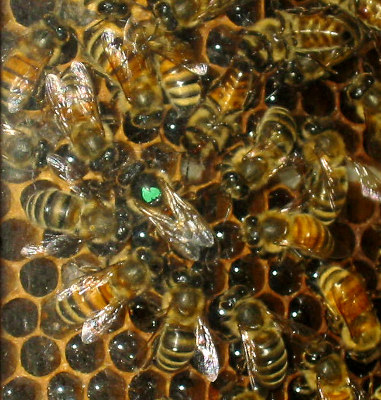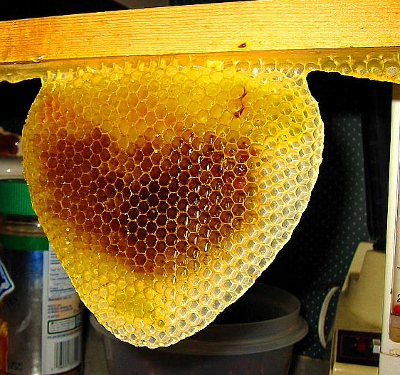
More causes of honeybee declines
 PJ Chandler argued that the
Langstroth hive is the root of many of the problems currently facing
beekeepers.
Michael Bush agrees that honeybees are in trouble, but instead traces
the ills to:
PJ Chandler argued that the
Langstroth hive is the root of many of the problems currently facing
beekeepers.
Michael Bush agrees that honeybees are in trouble, but instead traces
the ills to:
- Raising sickly bees.
Bush argues that the modern methods of pouring chemicals into the hive
to keep pests at bay ends up selecting for resistant super-pests...and
for wimpy bees that wouldn't be able to survive without
chemicals. In addition, since most honeybees now come from only a
few beekeeping companies, we've restricted the gene pool so much that
we're raising only a few inbred strains of bees, none or few of which
have the ability to live in a chemical-free hive. These bees have
also been bred to use less propolis, which might make it easier for the
beekeeper to pry the hive apart, but also makes allows viruses
to thrive among the bees.
 Using foundation that makes
bees sick.
I've written before that using foundation in
your hive makes your bees
create larger celled comb than they naturally would, which helps out
varroa mites. But did you know that the foundation you put in
your hive is processed beeswax from someone else's hive...who almost
certainly treated with lots of chemicals? The wax is impregnated
with pesticides, which causes drones raised on that foundation to be
less fertile and queens who mate with those drones to fail nine times
faster than a healthy queen would.
Using foundation that makes
bees sick.
I've written before that using foundation in
your hive makes your bees
create larger celled comb than they naturally would, which helps out
varroa mites. But did you know that the foundation you put in
your hive is processed beeswax from someone else's hive...who almost
certainly treated with lots of chemicals? The wax is impregnated
with pesticides, which causes drones raised on that foundation to be
less fertile and queens who mate with those drones to fail nine times
faster than a healthy queen would.- Upsetting the natural ecology of
the hive.
A healthy hive isn't just a couple of thousand bees; it also
includes beneficial fungi, bacteria, yeasts, mites, and insects.
It's helpful to think of a bee hive as a bit like our stomachs --- the
beneficial critters help "digest" (ferment) pollen while keeping the
hive from getting sick by crowding out pathogens. Using chemicals
in the hive is like taking antibiotics every day --- you kill the good
microorganisms along with the bad, so the system doesn't work as
well. In addition, feeding sugar water (pH 6.0) instead of
leaving bees enough honey (pH 3.2 to 4.5) creates an enironment that
helps the pathogens thrive.
Michael Bush's solutions --- while they can be hard to implement ---
are very simple. He says we have to stop using chemicals in our
hives, even if that means many of our colonies die and only the strong
remain. Deleting foundation allows bees to build clean wax at a
natural cell size. And we must make sure that our bees always
have enough honey rather than stealing too much and then feeding sugar
water. More on the specifics of his beekeeping method in
tomorrow's post.
| This post is part of our The Practical Beekeeper lunchtime series.
Read all of the entries: |
Want more in-depth information? Browse through our books.
Or explore more posts by date or by subject.
About us: Anna Hess and Mark Hamilton spent over a decade living self-sufficiently in the mountains of Virginia before moving north to start over from scratch in the foothills of Ohio. They've experimented with permaculture, no-till gardening, trailersteading, home-based microbusinesses and much more, writing about their adventures in both blogs and books.
Want to be notified when new comments are posted on this page? Click on the RSS button after you add a comment to subscribe to the comment feed, or simply check the box beside "email replies to me" while writing your comment.

Hi Anna,
Kathie writing this time from Blossomland. We are in the midst of beginning a new launch on classes and discussions called Blossomland U, the site for which will be up in a few weeks. Come July August we are going to start some web bee meetings called Hive Chats for information sharing. Perhaps you will join us at some point. Until then passing along your blog to our FB family...facebook.com/BlossomlandSupply
Keep up the good work! Kathie